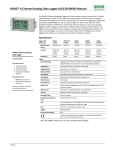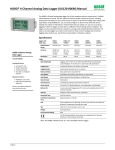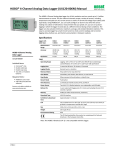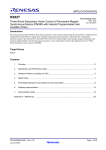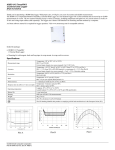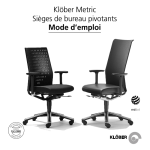Download Specifications Connecting the Logger
Transcript
HOBO® U12 Temp/RH/Light/ External Data Logger (Part # U12-012) Inside this package: • HOBO U12 Temp/RH/ Light/External Data Logger • Mounting kit with magnet, hook and loop tape, tie-wrap mount, tie wrap, and two screws. Doc # 13128-B, MAN-U12012-web Onset Computer Corporation Thank you for purchasing a HOBO data logger. With proper care, it will give you years of accurate and reliable measurements. The HOBO U12 Temperature/Relative Humidity/Light/ External Data Logger is a four-channel logger with 12bit resolution and can record up to 43,000 measurements or events. The external channel accepts a wide range of Onset and third-party sensors/transducers with a 0-2.5 VDC output, including external temperature, AC current, pressure, air velocity, and kW sensors. Specifications for Onset sensors can be found at www.onsetcomp.com or by contacting your Onset Authorized Dealer. For 0-5 VDC, 0-10 VDC, or 420mA output, use optional Onset Part No. CABLEADAP5, CABLE-ADAP10, or CABLE-4-20mA respectively. The logger uses a direct USB interface for launching and data readout by a computer. Onset software is required for logger operation. Visit www.onsetcomp.com for compatible software. Specifications Measurement range Accuracy Resolution Drift Response time in airflow of 1 m/s (2.2 mph) Time accuracy Operating temperature Battery life Memory Weight Dimensions Temperature: -20° to 70°C (-4° to 158°F) RH: 5% to 95% RH 2 Light intensity: 1 to 3000 footcandles (lumens/ft ) typical; maximum value varies from 1500 to 4500 2 footcandles (lumens/ft ) External input channel (see sensor manual): 0 to 2.5 VDC; 0 to 5 VDC (with CABLE-ADAP5) and 0 to 10 VDC (with CABLE-ADAP10) Temperature: ± 0.35°C from 0° to 50°C (± 0.63°F from 32° to 122°F), see Plot A RH: +/- 2.5% from 10% to 90% RH (typical), to a maximum of +/- 3.5%. See Plot B. Light intensity: Designed for indoor measurement of relative light levels, see Plot D for light wavelength response External input channel (see sensor manual): ± 2 mV ± 2.5% of absolute reading Temperature: 0.03°C at 25°C (0.05°F at 77°F), see Plot A. RH: 0.03% RH External Input Channels: 0.6 mV Temperature: 0.1°C/year (0.2°F/year) RH: <1% per year typical; RH hysteresis 1% Temperature: 6 minutes, typical to 90% RH: 1 minute, typical to 90% ± 1 minute per month at 25°C (77°F), see Plot C Logging: -20° to 70°C (-4° to 158°F) Launch/readout: 0° to 50°C (32° to 122°F), per USB specification 1 year typical use 64K bytes (43,000 12-bit measurements) 46 g (1.6 oz) 58 x 74 x 22 mm (2.3 x 2.9 x 0.9 inches) The CE Marking identifies this product as complying with all relevant directives in the European Union (EU). Plot A Plot B Plot C Plot D Connecting the Logger The U-Family logger requires an Onset-supplied USB interface cable to connect to the computer. If possible, avoid connecting at temperatures below 0°C (32°F) or above 50°C (122°F). 1. Plug the large end of the USB interface cable into a USB port on the computer. © 2009–2010 Onset Computer Corporation. Onset and HOBO are registered trademarks of Onset Computer Corporation. Other products and brand names may be trademarks or registered trademarks of their respective owners. HOBO U12 Temp/RH/Light/External Data Logger 2. Plug the small end of the USB interface cable into the bottom of the logger as shown in the following diagram. Using External Sensors The external input channel has a switched 2.5 V output. This signal can be used to power a sensor directly or it can also be used to trigger an external circuit. An external sensor should draw no more than 4 mA total when powered. The switched 2.5 V output turns on about 15 ms before the external channel is measured and stays powered for 48 ms after it is measured, as shown in the following diagram. The striped bar shows the 16 ms period during which the logger samples the input signal. If the logger has never been connected to the computer before, it may take a few seconds for the new hardware to be detected. Use the logger software to launch and read out the logger. Important: If you configure the logger to start with a button start, be sure to press and hold down the button on the front of the logger for at least three seconds when you want to begin logging. If using an external sensor, be sure to plug it into the side of the logger before logging begins. Also select the correct sensor and activate the external channel in the logger software when configuring the launch. Important: If you select an external channel, but do not plug the probe in, false data will be recorded for that channel. CAUTION: Analog channel input cannot exceed 2.5 VDC. For sensor outputs up to 10 VDC, use appropriate voltage adapter cable. Operation A light (LED) on the side of the logger confirms logger operation. You can read out the logger while it continues to log, stop it manually with the software, or let it record data until the memory is full. Channel 4 external input Refer to the software user’s guide for complete details on launching, reading out, and viewing data from the logger. Light Sample and Event Logging The logger can record two types of data: samples and events. Samples are the sensor measurements recorded at each logging interval (for example, the temperature every minute). Events are independent occurrences triggered by a logger activity. Examples of events recorded asynchronously during deployment include when the logger is connected to the host, when the battery is low, the end of a data file once the logger is stopped, and button pushes. The following table explains when the logger blinks during logger operation. When: The logger is logging Press the button on the front of the logger for one second to record an event. Both a button up and down event will be recorded. This is useful if you want to mark the datafile at a particular point. For example, if the logger is located in an incubator, you might press the button each time the door is opened. The logger is awaiting a start because it was launched in Start At Interval, Delayed Start, or Button Start mode The button on the logger is being pushed for a Button Start launch The logger stores 64K of data, and can record up to 43,000 samples and events combined. 2 The light: Blinks once every one to four seconds (the shorter the logging interval, the faster the light blinks); blinks when logging a sample Blinks once every eight seconds until launch begins Blinks once every second while pressing the button and then flashes rapidly once you release the button. The light then reverts to a blinking pattern based on the logging interval HOBO U12 Temp/RH/Light/External Data Logger Using the RH sensor Battery In order to take humidity measurements, the temperature sensor must be used in conjunction with the RH sensor. The logger requires one 3-Volt CR-2032 lithium battery. Expected battery life varies based on the temperature and the frequency at which the logger is recording data (the logging interval). A new battery will typically last one year with logging intervals greater than one minute. Deployments in extremely cold or hot temperatures or logging intervals faster than one minute may significantly reduce battery life. Conditions outside the recommended range may offset the RH signal. Vapors may also affect the RH sensor. The diffusion of chemicals into the sensor may cause a shift in both offset and sensitivity. High levels of pollutants may cause permanent damage to the sensor. Upon returning to normal conditions, the RH sensor will slowly return towards calibration state by itself. However, prolonged exposure to extreme conditions may accelerate aging and eventually lead to a permanent shift. To recondition the sensor, do the following: 1. Remove the battery 2. Warm 24 hours 80–90°C (176–194°F) at < 5% RH 3. Re-hydrate 48 hours 20–30°C (70–90°F) at 75–95% RH To replace the battery: 1. Disconnect the logger from the computer. 2. Unscrew the logger case. 3. Lift the circuit board and carefully push the battery out with a small blunt instrument, or pull it out with your fingernail. 4. Insert a new battery, positive side facing up. 5. Carefully realign the logger case and re-fasten the screws. Protecting the Logger WARNING: Do not cut open, incinerate, heat above 85°C (185°F), or recharge the lithium battery. The battery may explode if the logger is exposed to extreme heat or conditions that could damage or destroy the battery case. Do not dispose of the logger or battery in fire. Do not expose the contents of the battery to water. Dispose of the battery according to local regulations for lithium batteries. The logger can be permanently damaged by corrosion if it gets wet. Protect it from condensation. If it gets wet, remove the battery immediately and dry the circuit board with a hair dryer before reinstalling the battery. Do not let the board get too hot. You should be able to comfortably hold the board in your hand while drying. Note! Static electricity may cause the logger to stop logging. To avoid electrostatic discharge, transport the logger in an anti-static bag, and ground yourself by touching an unpainted metal surface before handling the logger. For more information about electrostatic discharge, visit http://www.onsetcomp.com/Support/support.html. Mounting There are four ways to mount the logger using the materials in the mounting kit included with the logger. • Use the hook and loop tape to affix the logger to a surface. • Attach the magnet and then place the logger on a magnetic surface. • Use the tie wrap and tie wrap mount to tie the logger to an object. 32 mm (1¼ inch) • Fasten the logger to a surface with the two Phillips-head screws. The back of the logger has two inserts for the screws, 32 mm (1¼ inches) apart. 3



